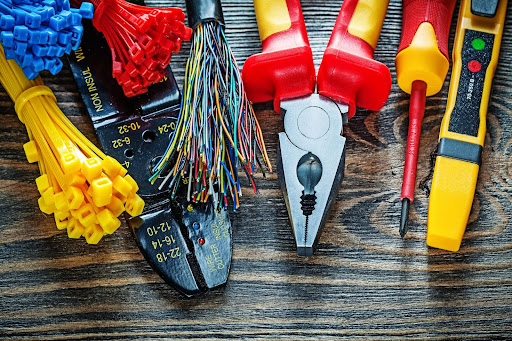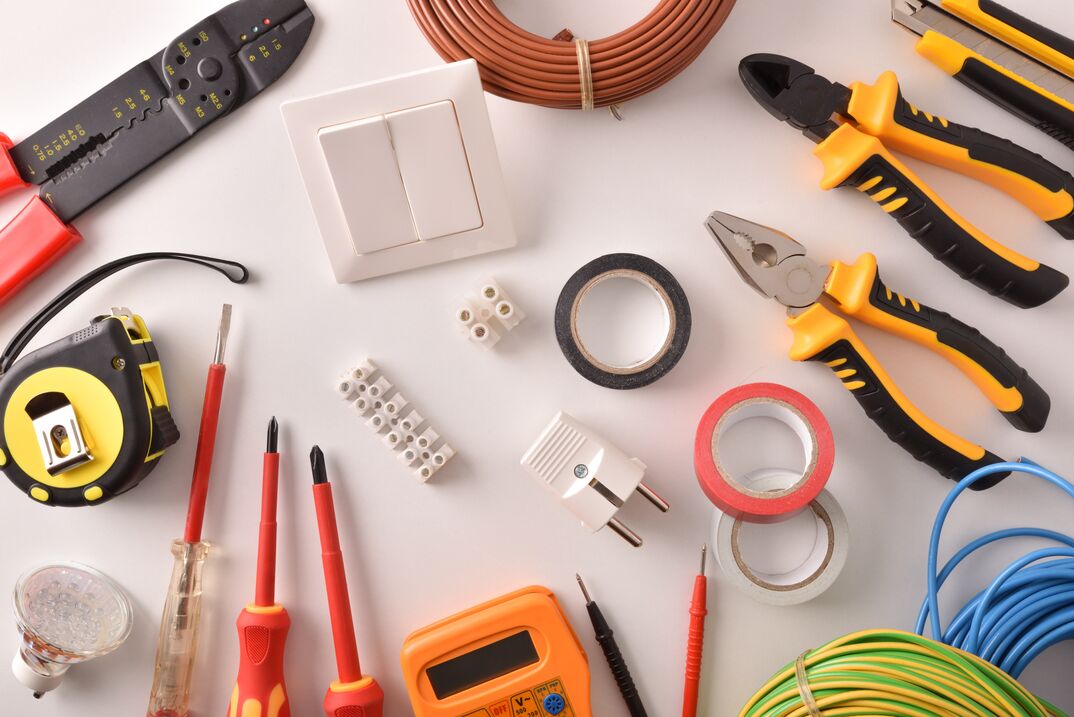Electrical Tools, Materials and Functions
Welcome to the world of electrical tools and their incredible uses! Whether you’re an aspiring electrician, a seasoned DIY enthusiast, or simply curious about the gadgets that power our modern lives, this post is here to shed light on the indispensable tools that make electrical work possible. From the basic essentials to the more specialized equipment, we will explore the diverse range of tools designed to handle various electrical tasks with precision and safety. So, fasten your seatbelts, grab your voltage testers, and let’s embark on an electrifying journey through the realm of electrical tools and their practical applications!
5 Benefits of Electrical Tools
1. Increased Efficiency:
One of the primary benefits of electrical tools is the significant boost in efficiency they provide. These tools are designed to automate and streamline various tasks, allowing users to complete their work more quickly and accurately. For example, power drills can effortlessly drive screws or drill holes in a fraction of the time it would take using manual tools. This increased efficiency enables professionals to complete projects faster, saving both time and effort.
2. Enhanced Precision:
Electrical tools are engineered with precision in mind, ensuring accurate measurements and precise results. For instance, digital multimeters provide precise readings of voltage, current, and resistance, enabling electricians to troubleshoot and diagnose electrical issues with pinpoint accuracy. This level of precision not only improves the quality of work but also minimizes the chances of errors or mistakes.
3. Improved Safety:
Safety is paramount when working with electricity, and electrical tools are specifically designed to prioritize user safety. Many tools incorporate insulation, grounding features, and safety mechanisms to protect against electric shocks, short circuits, or other potential hazards. For example, insulated screwdrivers reduce the risk of electrical shock when working on live circuits. Additionally, circuit breakers and residual current devices (RCDs) enhance safety by detecting electrical faults and interrupting the current flow. By utilizing these tools, professionals can significantly reduce the risk of accidents and injuries.
ALSO SEE: 20 Common Farm Tools and Equipment
4. Time and Labor Savings:
Electrical tools can save significant amounts of time and effort, reducing the physical strain and manual labor required for various tasks. For example, wire strippers eliminate the need for manually stripping insulation from wires, saving time and preventing potential damage to the conductors. Similarly, cable pullers and fish tapes simplify the process of routing cables and wires through conduits, reducing the need for excessive pulling and maneuvering. These time and labor-saving benefits enable professionals to work more efficiently and tackle larger projects with ease.
5. Versatility and Adaptability:
Electrical tools are designed to handle a wide range of tasks, offering versatility and adaptability in various scenarios. Many tools come with interchangeable bits, blades, or accessories that allow users to perform different functions with a single tool. For example, a rotary tool with different attachments can cut, grind, polish, and even engrave materials, making it incredibly versatile for multiple applications. This versatility reduces the need for multiple specialized tools, saving space, and cost while providing flexibility in handling different tasks.
Important Electrical Tools and Their Uses
1. Pliers:
Pliers are essential cutting and gripping tools for electrical technicians. They come in various types, including long nose pliers for precise tasks, side-cutting pincers for cutting wires, and reaming forceps for fixing locknuts and fittings. Pliers provide a firm grip, facilitate wire bending, twisting, and fixing, and are crucial for any electrician’s tool kit.
2. Screwdrivers:
Insulated screwdrivers are indispensable for electrical work, allowing technicians to loosen and fasten various hardware components safely. Many professionals opt for screwdriver sets with interchangeable bits for versatility in different applications.
3. Tape Measure:
Accurate measurements are crucial when working with wiring. A retractable measuring tape, with features like magnetic tips and multi-step locks, ensures precise cuts and strips, facilitating efficient electrical installations.
4. Electrical Tape:
Electrical tape, made from materials like plastic, vinyl, or fiberglass fabric, is a pressure-sensitive adhesive used to insulate wires and prevent accidental contact or electric shock. It acts as a protective barrier, safeguarding against electrical flow and potential hazards.
5. Cable Ties:
Cable ties, also known as zip ties, are inexpensive fasteners used to bind and organize electrical cables and wires. They help maintain a neat and tidy electrical space, preventing tangling and improving cable management.
6. Electric Drills:
Electric drills are versatile tools for electrical technicians. They are used for installing lighting fixtures, accessing wiring, and performing various tasks. With different bits available, electric drills facilitate faster and more efficient work.
7. Wire/Cable Lugs:
Wire and cable lugs are connectors that link wires to appliances, cables, and other devices requiring power. Similar to the features found on jumper cables and vehicle batteries, these lugs ensure secure and reliable connections.
8. Coax Connector:
Coax connectors are used to interface cables with devices while protecting the cable from damage. Having a variety of connectors on hand ensures compatibility and meets the specific needs of clients.
9. Level:
A level is an essential tool for installing light fixtures accurately. It helps electrical technicians ensure that fixtures, screws, and other components are precisely positioned.
10. Wire Strippers:
Wire strippers are used to remove the plastic sheathing from wires, exposing the copper for making connections. They come in various models and types, enabling electricians to customize their wiring and create reliable connections.
11. Fish Tape:
Fish tape is a popular tool used by electrical technicians to run wiring through conduit piping. It is housed in a retractable coil and allows for easy routing of wires between electrical components.
ALSO SEE: Top Medical tools used in Hospitals
12. Fishing Rods:
Fishing rods, typically made of fiberglass, are used to guide wires through walls, under carpets, or above ceilings. They often feature hooks on the end for convenient maneuvering.
13. Voltage Tester:
A handheld voltage tester is a crucial tool for safely working with electricity. It allows electricians to test for the presence of electrical power, ensuring a safe working environment. Non-contact voltage testers are also available, detecting current without physical contact.
14. Terminal Block:
Terminal blocks are modular, insulated devices that help electricians organize and connect multiple wires. They are commonly used for grounding, as well as connecting switches and outlets to the main power source.
15. Conduit Bender:
Conduit benders are essential tools for shaping conduit piping to accommodate wiring routes. They allow electricians to bend the piping precisely, ensuring a non-intrusive and efficient installation.
16. Reaming Bit:
A reaming bit, attached to an electric drill, widens conduit piping openings to connect different sections securely. It facilitates the secure joining of conduit pipes, completing a reliable conduit system.
17. Splicing Connector:
Splicing connectors are plastic clips that enable electricians to quickly make connections between various wire sections. They are widely used with device wires, telephone cables, and electrical cables.
18. Flashlights:
Working in dark or low-light environments poses risks for electricians. Flashlights and work lights are essential tools to ensure visibility and safety while examining wiring or operating power tools.
19. Safety Glasses:
Electricians need to protect their eyes during close inspections, wire cutting, and power tool operations. Safety glasses are essential personal protective equipment (PPE) for maintaining eye safety on the job.
20. Rescue Rod/Hook:
Rescue rods or hooks are used to remove large objects or unconscious individuals from hazardous electrical areas. They allow emergency responders to safely move victims away from live electrical sources.
21. Circuit Analyzers:
Circuit analyzers are digital handheld tools that provide instant information about electrical circuits associated with specific outlets. They measure voltage, polarity, line voltage, and other parameters, aiding in diagnostics and troubleshooting.
22. Circuit Finders:
Circuit finders help electricians identify which outlets are connected to specific circuits in a building. They consist of a handheld digital transmitter and a receiver that plugs into outlets. By sending signals, they assist in locating the circuit to which an outlet belongs.
23. Wire Cutters:
Wire cutters, also known as diagonal cutters or wire snips, are specialized pliers designed to cut through electrical wires cleanly and effectively. They are essential for trimming and cutting wires to the desired length.
24. Crimping Tool:
A crimping tool is used to create secure and reliable connections between wires and terminals. It compresses metal sleeves (crimp connectors) onto the stripped ends of wires, providing a strong electrical connection.
25. Circuit Breaker Finder:
A circuit breaker finder is a tool that helps locate specific circuit breakers in an electrical panel. It consists of a transmitter that plugs into an outlet and a receiver that scans the circuit breakers, indicating which one corresponds to the outlet.
26. Wire Fish Tape:
Wire fish tape, also known as electrical fish tape, is a flexible, thin, and flat steel tape used for pulling wires through conduits or walls. It assists in routing wires efficiently and accurately.
27. Wire Tracer/Toner:
A wire tracer or toner is a tool used to identify and trace the path of electrical wires in a building. It involves sending a signal or tone through a wire, allowing electricians to locate and track the wire’s route.
28. Insulation Resistance Tester:
Insulation resistance testers, also called megohmmeters or meggers, are used to measure the insulation resistance of electrical cables, wires, and equipment. They help identify potential insulation faults or degradation.
29. Wire Strain Relief Tool:
A wire strain relief tool is used to secure and protect cables or wires where they enter electrical devices or connectors. It relieves strain on the wires, preventing them from being pulled or damaged.
30. Wire Pulling Grips:
Wire pulling grips, also known as cable pulling grips or wire mesh grips, are used to securely grip and pull wires through conduits or tight spaces. They provide a strong hold on wires, preventing slippage during the pulling process.
31. Tone and Probe Kit:
A tone and probe kit is a set of tools used for tracing and identifying wires in a network or telecommunications system. It includes a tone generator that sends a signal and a probe that detects the signal, allowing for wire tracing and troubleshooting.
In conclusion, electrical tools are indispensable for professionals and enthusiasts working with electrical systems. These tools offer a wide range of benefits that significantly improve efficiency, precision, safety, and overall productivity. From pliers and screwdrivers to tape measures and cable ties, each tool serves a specific purpose in tackling electrical tasks.
The use of electrical tools enhances efficiency by automating tasks, reducing labor and time required to complete projects. The precision offered by these tools ensures accurate measurements and reliable connections, minimizing the risk of errors and improving the quality of work.
By utilizing the right electrical tools, professionals can enhance their capabilities, achieve better results, and work more efficiently and safely. These tools not only save time and effort but also contribute to the overall success of electrical projects.
